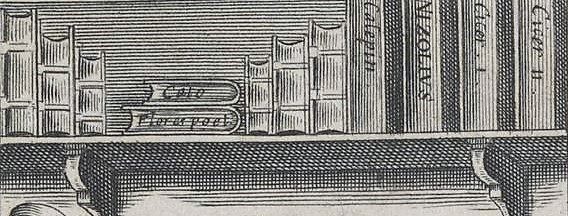Libraries Without Walls
Suggested Assigned Reading
William Sherman, John Dee (Amherst, MA, 1995), pp. 29-52.
Roger Chartier, “Libraries without Walls” Representations 42 (1993): 38-52.
John Dee, A Compendious Rehearsal (London, 1842), chapter 7.
Learning Outcomes
Discuss the practices of organizing and recovering knowledge practiced by early modern readers.
Integrate the individual practices within the larger history of reading and information culture in Renaissance and early modern Europe.
Critique the theoretical approaches of modern scholars to reading and library construction using examples from the AOR corpus.
Procedure
1. Look at the following examples of how the annotators in AOR gather together books:
Gabriel Harvey:
 A bibliography on the verso of the title page in Niccolò Machiavelli’s, Art of warre (London, 1573)
A bibliography on the verso of the title page in Niccolò Machiavelli’s, Art of warre (London, 1573)
 A meditation on the use of history following the preface to Titus Livius, Romanae historiae principis (Basel, 1555)
A meditation on the use of history following the preface to Titus Livius, Romanae historiae principis (Basel, 1555)
On page “432” in Lodovico Domenichi’s Facetie (Venice, 1571), and Lodovico Guicciardini’s Detti et fatti (Venice, 1571), Harvey has included a short bibliography on jokes and joking. How does it compare to the lengthier notes you’ve seen previously?
page “432” in Lodovico Domenichi’s Facetie (Venice, 1571), and Lodovico Guicciardini’s Detti et fatti (Venice, 1571), Harvey has included a short bibliography on jokes and joking. How does it compare to the lengthier notes you’ve seen previously?
John Dee:
 On a rear flyleaf of Geoffrey of Monmouth’s Brittaniae vtriusque regum (Paris, 1517), John Dee has noted several of his contemporaries who have “muniments:” histories, chronicles, or other documentations relating to the history of England. Why do you think Dee is so interested in their owners, both present and past?
On a rear flyleaf of Geoffrey of Monmouth’s Brittaniae vtriusque regum (Paris, 1517), John Dee has noted several of his contemporaries who have “muniments:” histories, chronicles, or other documentations relating to the history of England. Why do you think Dee is so interested in their owners, both present and past?
 The references to authors on this page of Geoffrey of Monmouth’s Brittaniae vtriusque regum (Paris, 1517), all come from a specific reference book, John Bale’s Catalogue of Illustrious British Authors (tagged in many of the marginal notes). Dee’s copy of this book is also kept in the same collection as his copy of the Historia, that of Christ Church, Oxford.
The references to authors on this page of Geoffrey of Monmouth’s Brittaniae vtriusque regum (Paris, 1517), all come from a specific reference book, John Bale’s Catalogue of Illustrious British Authors (tagged in many of the marginal notes). Dee’s copy of this book is also kept in the same collection as his copy of the Historia, that of Christ Church, Oxford.
 Dee’s notes on the endleaf of Paracelsus’s Baderbuchlin (1562) combine the practices above.
Dee’s notes on the endleaf of Paracelsus’s Baderbuchlin (1562) combine the practices above.
2. Return to one of the pages linked above and use a hyperlinked book or author to launch a search in the AOR database. Does it return hits in other books?
3. Can you find the same (or similar) notes in different books? What purpose might this serve for the annotator?
4. Save your findings for class discussion [How to Export to HTML].
Questions for Discussion
What (or who) is the library catalogue for these readers and where is that catalogue most likely to be located? What knowledge about the books in this library is not written down? Where might we look for it?
Discuss Chartier’s examination of the Bibliotheque bleue in light of the bibliographical index in Gabriel Harvey’s Art of Warre and John Dee’s copy of the Historia Regum Britanniae. In what ways are these collections “libraries”?
What differences do you notice between the “book collections” made by Harvey and by Dee in these notes?
Back to Teaching with AOR | Next Exercise: Print, Script, and Image


